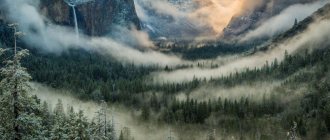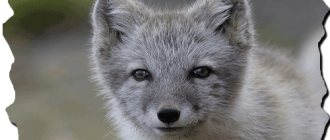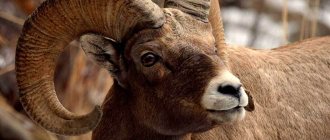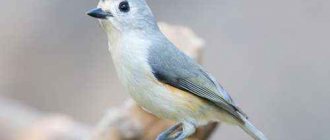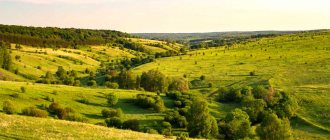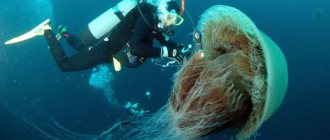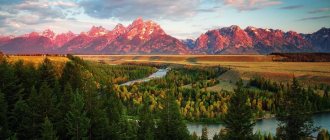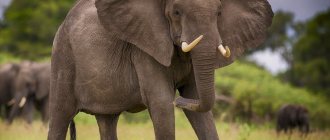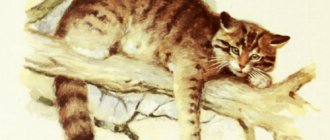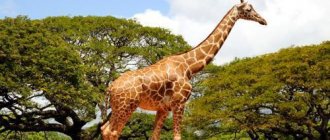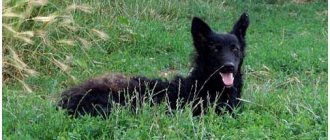The climate of North America is cold in the subpolar part, temperate in the subtropical part and warm in the tropical part. The wide variety of natural areas provided the basis for the development of diverse animal populations. Thanks to this, the continent is inhabited by extraordinary representatives of the fauna, which easily overcome unfavorable natural conditions, expressed by kilometer-long glaciers, hot and sultry deserts, and areas with high moisture. In the north of America you can find polar bears, bison and walruses, in the south - rodents, roe deer and partridges, in the central part of the continent - a huge variety of birds, fish, reptiles and mammals.
Canadian beaver
The Canadian beaver is one of two living species of the beaver family, the other being the common beaver, or river beaver, found in Europe and Asia, and is also the national animal of Canada. After the capybara, they are the second largest rodent in the world, and can reach a weight of over 30 kg. Canadian beavers are stocky animals with compact bodies and short legs. Their feet are webbed, and their tails are wide, flat and covered with scales. To protect themselves from predators or adverse weather conditions, the Canadian beaver constantly builds dams from sticks, leaves, mud and branches.
Animals of North America
Page 1 of 2
In the subpolar part of North America the climate is cold, arctic; further south it is temperate, turning into subtropical and even tropical. Natural areas are in many ways reminiscent of the natural areas of the Eurasian continent. In the very north there are tundras, to the south there are coniferous, then broad-leaved forests, but the steppes and deserts extend not from west to east, but from north to south. Many representatives of the flora and fauna of the Old and New Worlds are similar. This is explained by the fact that relatively recently (on a geological time scale) Asia and America were connected by a giant “bridge” - Beringia, located on the site of the modern Bering Sea. Animals, birds, insects and plant germs freely migrated along this “bridge”. Later, this area of land sank under water, communication was interrupted, and life on each continent began to develop independently.
In North America you can find many of “our” animals. There are brown bears, wolves, moose, red deer and reindeer. On the other hand, American forests are home to marsupial opossums, armadillos, and hummingbirds - species unique to American nature. This is the only place on Earth where you can find forests of sequoia - an amazing coniferous tree that can live for more than 3,000 years and grow up to 100 meters in height. height. Only in the American deserts do cacti grow, represented by many species - from small, familiar indoor plants to huge ones, several meters high.
Snow goat
Snow goats live in the mountains of North America. Their favorite places are steep slopes, where they feel completely safe. Not every predator is able to move here without the risk of falling into the abyss. Goats, on the other hand, move very freely, deftly jumping from rock to rock. In winter, when there is a lot of snow, they descend from the high mountains to lower ones.
Snow goats have thick, warm, pure white fur. Both males and females have horns. Kids are born in the spring. Within a few minutes after birth, they get to their feet and are able to quickly run after their mother. In the first days, the kids are not yet able to make dizzying jumps over the abyss, but it will not take much time for them to get stronger and begin to move fearlessly in the mountains. Snow goats, like other mountain ungulates, feed on various grasses, twigs of bushes and trees, and moss.
Raccoon
The striped raccoon is one of the most common animals in North America. Raccoons are found in forested areas from the tropical zone to Canada. In the north, raccoons are active only in the summer months, but in winter they go into hibernation. In forests, these animals stay in bodies of water: forest streams, small dams or large lakes - and rarely stray far from them.
Raccoons are excellent tree climbers and excellent swimmers. They eat almost everything, but most of all they love insects, frogs and various parts of plants: seeds, fruits, nuts and berries. Sometimes I don’t mind snacking on bird eggs and chicks. Before eating, raccoons almost always rinse their food in water to soften it. This innate habit sometimes fails raccoons. If you give a captive animal a piece of sugar, it will also rinse it in water and then look at its empty paws in bewilderment.
Raccoons are crepuscular animals and come out to hunt in the evening or morning. The day is spent in hollows or rock crevices. Raccoons, as valuable fur-bearing animals, have been acclimatized in many places in Europe, the Caucasus and the Far East.
Buffalo
The closest relative of the European bison, the bison, lives in North America. Outwardly, these animals are quite similar, but the bison has a more massive and wider front part of the body, a larger forehead, and shorter legs. A little over a century ago, about 100 million bison lived on the American continent. Their habitats were both forests and prairies. The Indians hunted buffalo, but killed only enough for food. When the herds left, the Indians followed them.
The white colonists, trying to inflict maximum damage on the Indians, began the merciless destruction of these powerful animals. Animals were killed at every opportunity: they were shot from the windows of passing trains, they were chased on horseback. Most of the bison were killed for fun; Europeans practically did not use their carcasses. The Indians, having lost their “breadwinners,” died out or went to other places. Having destroyed the bison, the colonists populated the prairies with cows and sheep. By the beginning of the 20th century. bison were on the verge of extinction. Only a few hundred individuals remained, miraculously surviving in the dense forests. And then people finally took up the task of saving these beautiful animals: hunting them was banned, nature reserves were created, and scientists began breeding them. Now the number of bison is stable and does not cause alarm.
Grizzly
A subspecies of our brown bear, the grizzly, lives in the north of the American continent. It got its name because of the color of its fur (in English, “grizzly” means “gray”). These are powerful bears, they are larger than the European subspecies and are almost identical in size to the Far Eastern brown bears. Standing on its paws, a large grizzly bear reaches a height of 3 m. The size of grizzlies is often exaggerated, but among them there are indeed giants weighing up to 600 kg. Such giants, as a rule, live in nature reserves where food can be easily found.
In national parks, grizzlies are not afraid of visitors. They are often seen calmly walking along roads and tourist sites. People are forbidden to feed bears because, once they get used to it, they become dangerous and may attack when demanding food. In the wild, grizzlies, like all brown bears, feed mainly on plant foods and invertebrates.
Noble deer
Red deer are common in Northern Eurasia and North America. There are more than a dozen of their subspecies. For example, in Siberia they are represented by deer, in Transbaikalia by wapiti, and in America by wapiti.
Wapiti are large and slender deer; the weight of males can reach 300 kg. Only males have horns, which act as tournament weapons. In autumn, males gather around themselves a harem of 2-5 females. At this time they are very aggressive, breaking small trees, ripping up the ground with their hooves and emitting a terrible roar. Fierce fights break out between males. Rivals fight with their horns, trying to knock each other down, but there are almost never deaths. The deer stand nearby, obediently awaiting the winner. With the end of the rut, rival males, forgetting past grievances, gather in bachelor groups or live alone, while females and young animals gather in herds. At the beginning of spring, males shed their antlers, and within a few days new growth begins. Summer - fragile, skin-covered deer antlers are called antlers. They are filled with blood and rich in a variety of chemically active substances from which medicines are prepared. In May, the female gives birth to one or two spotted fawns. For several days the babies lie in the grass, and the female grazes nearby, approaching them only to feed. The fawns remember the large white spot around the mother's tail and then always and everywhere follow it relentlessly.
Caribou
In the north of North America live wild deer, relatives of the domesticated reindeer of Eurasia. They are called caribou (from the Indian “xalibu”, which means “snow shoveler”). Caribou are somewhat larger than their Eurasian relatives, and their horns are slightly smaller. Most of these reindeer spend the summer in the tundra, far to the north, and in the fall they gather in large herds and move south to spend the winter in the forest. They are excellent swimmers and easily cross rivers and other bodies of water. Caribou feed on grass and lichen, and in the forest they also feed on branches and leaves. The so-called forest caribou live their entire lives in the forest and almost never wander. Eskimos and other Arctic inhabitants could not live without reindeer, which provide them with meat, hides and furs.
red lynx
This agile cat with a short tail is a close relative of the common lynx, found in the forests of Canada, Europe and Asia. Unlike their feline relatives, although their habits and lifestyle are very similar, the red lynx lives in the warmer regions of North America. This solitary nocturnal predator feeds on small mammals and birds, but sometimes does not disdain carrion. During the daytime, she hides in rock crevices, tree hollows, and sometimes behind waterfalls.
The mating season begins in the spring. Lynx carry their cubs for about 9 weeks. Males do not help the female raise the cubs, and young animals become independent quite early, sometimes leaving their mother in the fall.
Black-footed ferret
A couple of years ago, this animal, persecuted by hunters and suffering from unfavorable environmental conditions, was almost completely driven out of its natural habitats.
At one time, the ferret's main food was prairie dogs. The small predator could easily penetrate the narrow burrows of these rodents. Farmers have been killing off so many prairie dogs in recent years that it appears that the black-footed ferret will now only be able to find enough food to survive in areas where the environment is protected.
Bighorn sheep
Bighorn sheep live in the mountains and Great Plains of North America. Its skin is brown with a large white spot at the back. Males have large, heavy, spiral-twisted horns; females have smaller and lighter ones. In summer, males and females live separately from each other. In the fall they come together to mate, and the males engage in fierce battles with each other, clashing their large horns.
Bighorn sheep eat a variety of plants.
Coyote
Coyotes are one of the most common mammals in the United States. They live in deserts, snowy tundra, shady forests and vast open expanses of prairie. Just like his relative the wolf, he eats meat, but does not refuse fruits, berries, eggs and even carrion.
Coyotes live in groups that vary in size. If there is large prey in their habitat, they, like wolves, unite in large packs. If their main food consists of small rodents, coyotes live in families. The parents hunt together, using different hunting tactics. It is said that coyotes can even catch magpies and crows by pretending to be dead.
California sea lion
Dexterous “artists”—California sea lions—often perform in circus programs. These representatives of the pinniped order are easily kept in captivity and trained. In nature, they are found on the Pacific coasts of the USA and Japan. They don’t swim far from the shore. They feed on squid and fish, mainly herring. An adult animal requires up to 30 kg of fish per day. Sea lions are excellent swimmers. They are able to dive to depths of up to 80 m and stay under water for a long time. During the breeding season, sea lions come to land and form rookeries. Lion cubs are born with beautiful golden fur, which changes to chocolate brown after molting. They begin to swim at the age of ten days and gradually spend more and more time in the water, frolicking together for a long time. Mothers easily recognize their babies by voice and smell. Their main enemies are sharks and killer whales, which often attack them in the open sea. In captivity, sea lions live up to thirty years.
Mississippi alligator
Alligators differ from crocodiles by their short snout and relatively small size - up to 2-2.5 m. The Mississippi alligator is common in the southern United States, in humid and warm tropical areas. All crocodiles are semi-aquatic animals. Their tail is flattened laterally and their paws are webbed. The nostrils and eyes are raised above the surface of the muzzle, allowing them to breathe and observe while submerged. Thanks to their huge lungs, crocodiles can stay underwater for a long time.
Sometimes, in order to remove excess salts from the body, crocodiles cry. Salts come out with tears. This phenomenon gave rise to many legends about “crocodile tears”. Alligators are active predators. Their main prey is fish, frogs, and crayfish. They are also adept at catching birds and small mammals. They do not disdain carrion. When hunting, they lie motionless, immersed in water, cleverly disguising themselves as vegetation or snags, and wait for an unwary prey. A sharp throw, the closing of the powerful jaws - and the prey cannot escape from the teeth of the predator. Alligators reproduce by laying eggs covered with a strong shell. The female guards the nest and the hatched babies. People exterminated alligators in large numbers for their valuable skin. Nowadays these are rare animals.
Rattlesnake
Most venomous snakes in North America are rattlesnakes, or rattlesnakes. They got their name from the rattle, also called a rattle, at the tip of the tail, which is formed by hard leathery covers. When irritated, the snake moves the tip of its tail. The resulting sound, according to biologists, serves as a signal for grazing large mammals so that they can hear the approach of snakes from afar. At night, snakes crawl out into the desert or prairie in search of food. They feed mainly on mice and other small rodents. Near the eyes, the snake has so-called thermolocator pits that are sensitive to thermal radiation, which, with the help of organs that perceive infrared rays, serve to detect warm-blooded animals. Therefore, rattlesnakes can hunt even in complete darkness.
- To the begining
- Back
- 1
- Forward
- In the end
Brown bear
The brown bear is one of the largest and most powerful land predators in North America. These bears are equipped with non-retractable claws that are used primarily for digging and also provide good traction when running. Despite their body weight of over 500 kg, these animals reach speeds of up to 50 km per hour. The name of the animal speaks for itself; brown bears have dark brown or yellowish-brown fur.
Reptiles, amphibians
North America is a continent characterized by a variety of landscapes that stretch from the Arctic in the far north to the narrowest part of Central America in the south. Many unpretentious reptiles and amphibians feel very comfortable in such climatic conditions.
Anole Knight
A large lizard from the infraorder Iguanaidae has a very long and powerful tail. The upper side of the body is green or brownish-yellow in color with two yellowish stripes coming from the forelimbs. Anoles that do not reproduce are distinguished by a greenish throat sac, and in sexually mature individuals this part of the body is bright pink.
Arizona adder
A snake from the Aspida family, with a very small head and an extremely thin body. The color is represented by black, yellow and red rings located alternately on the body. An important feature of the structure of the dental apparatus is the presence of a small tooth on the maxillary bone behind the poisonous fang.
Corn snake
A non-venomous snake known as the gutata and the red rat snake. The length of an adult individual is 120-180 cm. There is a very wide variety in color, which is especially noticeable given the ongoing selections. The snake's natural coloration is orange with black stripes surrounding red spots.
Red rattlesnake
Poisonous snake from the Viper family. The reptile has a wide head and a very slender body. The coloration is brick red, pale reddish brown or bright orange with large diamond ridges along the back, bordered by pale scales. There are narrow white and black rings on the tail in front of the rattle.
Black iguana
A relatively large lizard from the Iguana family with very clearly defined sexual dimorphism and a dorsal crest represented by long spines running along the central part of the back. The iguana's skin is black, with a white or cream pattern. The body is strong, with well-developed limbs and strong fingers.
Ordinary cyclure
A rare lizard from the Iguana family, inhabiting dry pine forest zones, bushes, and coastal vegetation strips. The reptile feeds on food of plant origin. Adults hide in rock cracks, limestone or in burrows dug in sandy loam soils. Young lizards settle in trees.
Dekey's snake
A non-venomous reptile from the Colubridae family. Representatives of the species are characterized by a very small head and a long and slender body. The color of the back is brownish or grayish-brown, and there is a wide light stripe along the ridge. The belly is pale pink. The snake settles near water bodies, avoiding dry and open spaces.
Return to content
American alligator
Not as dangerous as their reptile reputation, but still common enough in the southeastern United States to puzzle locals. Some adult alligators can reach lengths of more than 15 feet and weights of about 1,000 pounds, but most are much more modest in size, even given the tendency of Florida residents to greatly exaggerate the size of alligators when calling 911.
The habit of individual citizens feeding American alligators is not the best activity that accustoms animals to contact with people, and as a result can result in death.
North American kakimitsli
The North American kakomitsli is also called the Californian kakomysl. This animal appears to be native to Australia, but can be found in the south, southwest, or west coast of the United States. Despite the fact that this mammal is the symbol of the state of Arizona, it is difficult to find it there. This is due to the fact that kakimitsli are nocturnal and solitary animals that avoid meeting people. They are also quite small, weighing only 0.5-1 kg and about 60 cm long, with the tail making up about half the length.
Despite its shyness, this species is easily tamed. And although the animal is not a cat, but a raccoon, miners and settlers used them to get rid of mice, rats and other vermin.
Danaid monarch
Every schoolchild knows that the monarch butterfly has a dark body with white spots, as well as bright orange wings with a black border and veins (sometimes there are white spots in the black parts of the wing). The monarch is poisonous to insect predators due to toxins in the milkweed that monarch caterpillars feed on before metamorphosis, and their bright colors act as a warning to potential enemies.
The monarch butterfly is best known for its incredible annual migrations, from southern Canada and the northern United States to Mexico.
Insects
North America belongs to the category of continents that are unique in their climatic and landscape characteristics. The insects inhabiting these territories are very diverse, and their activity occurs both during the daytime and at night.
Best articles: Earth's continents ordered by area and population
Apollo Phoebus
A butterfly similar in appearance to Parnassius apollo. The insect is medium in size and has cream-colored wings. On the general white background of the wing there is light pollination by not too dark scales. A distinctive species feature is represented by black and white antennae and a pair of red spots with a black border on the hind wings.
Hessian fly
The dangerous cereal pest has the body shape of a mosquito and short antennae. The wings of the dipterous insect are gray-smoky, with a pair of longitudinal veins, one of which bifurcates in the middle. The legs are thin and long, reddish in color. The abdomen is relatively narrow, with a characteristic point.
Dirty predator
The bug of the Predator family is distinguished by its large size. The insect is characterized by a brown or almost black body color and reddish legs. The head is small in size, has fairly large eyes and a relatively long proboscis. The antennae are long, covered with fine hairy bristles.
Jaundice Meadi
A diurnal butterfly from the white butterfly family with a golden-orange background color on the wings of males and a lilac-pink fringe. The border on the outer edge of the wings is dark brown. At the top of the central cell of the wings there is an oblong black spot, and on the underside of the hind wings there is a discal spot without a blurred border.
Rapeseed flower beetle
A representative of the beetle species of the subfamily Meligethinae. The insect is distinguished by its black coloration with the presence of a bluish or greenish tint characteristic of the species. This beetle overwinters on the soil, under the remains of plants. Adults damage the stigmas and stamens of vegetation.
Black dragonfly
A representative of the genus Sympetrum with a prothorax with a large, almost vertical protrusion, which bears a fringe in the form of long hairs. On the side seams there are black stripes bordering three yellow spots and merging into one fairly wide stripe. The legs are completely black or with numerous black stripes.
Sailboat cresfontes
One of the largest North American butterflies of the family Papilionidae. The undersurface of the black wings is distinguished by the presence of a very noticeable diagonal stripe of yellow edged on the edges of the hind wings. The ventral surface of the wings is predominantly yellow.
Ocellated click beetle
An insect with an elongated and flattened body shape. On the pronotum of the ocellated click beetle there is a pair of black spots in the shape of eyes, occupying a third of the total area of the entire upper part. The black spots have a white border, which makes them look like eyes and allows the insect to escape from some predators.
Cactus moth
A lepidopteran insect from the Ognevka family settles on prickly pear cacti, which it feeds on, very effectively limiting the total number of such vegetation. The small butterfly is brownish-gray in color and has long legs and antennae. On the front wings there is a pattern in the form of characteristic stripes, and the hind wings are white.
Nine-banded armadillo
The most widespread species of the armadillo family in the world, found in North, Central and South America. The length of the body of the nine-banded armadillo with the head is from 38 to 58 cm, the tail from 26 to 53 cm, and the average body weight ranges from 2.5 to 6.5 kg (maximum 10 kg). They are solitary, nocturnal, insectivorous mammals, which explains why they are often killed by cars on North American highways. Amazing is the fact that the nine-banded armadillo is capable of jumping over a distance of more than a meter.
Rainforest Plants
The world's rainforests are home to an incredible number of plant species. In the Amazon tropics alone there are over 40,000 plant species! The hot, humid climate provides ideal living conditions for the biome. We have selected for your reference the most interesting and unusual plants, in our opinion.
Epiphytes
Epiphytes are plants that live on other plants. They do not have roots in the ground and have developed various strategies to obtain water and nutrients. Sometimes one tree can be home to many species of epiphytes, together weighing several tons. Epiphytes even grow on other epiphytes!
Many of the plants on the list of tropical forests are epiphytes.
Bromeliad epiphytes
The most common epiphytes are bromeliads. Bromeliads are flowering plants with long leaves arranged in a rosette. They attach themselves to the host tree by wrapping their roots around the branches. Their leaves direct water to the central part of the plant, forming a kind of pond. The bromilia pond itself is a habitat. Water is used not only by the plant, but also by many animals in the rainforest. Birds and mammals drink from it. Tadpoles grow there and insects lay eggs
Best articles: First and modern photosynthetic organisms
Orchids
There are many types of orchids found in tropical forests. Some of them are also epiphytes. Some have specially adapted roots that allow them to capture water and nutrients from the air. Others have roots that spread along the branch of the host tree, capturing water without going deep into the ground.
Acai Palm (Euterpe oleracea)
Acai is considered the most common tree in the Amazon rainforest. Despite this, it still represents only 1% (5 billion) of the region's 390 billion trees. Its fruits are edible.
Carnauba palm (Copernicia prunifera)
This Brazilian palm is also known as the "tree of life" because it has many uses. Its fruits are eaten and its wood is used in construction. It is best known as the source of “carnauba wax,” which is extracted from the leaves of the tree.
Carnauba wax is used in car polishes, lipsticks, soaps and many other products. They even rub it on surfboards to achieve maximum glide!
Rattan Palm
There are more than 600 species of rattan palms. They grow in African, Asian and Australian rainforests. Rotans are vines that cannot grow tall on their own. Instead, they wrap themselves around other trees. The gripping spines on the stems allow them to climb other trees towards the sunlight. Rotans are collected and used in furniture construction.
Rubber tree (Hevea brasiliensis)
The rubber tree, first discovered in the Amazon tropics, is now grown in tropical areas of Asia and Africa. The sap that the tree bark exudes is collected to produce rubber, which has many uses, including car tires, hoses, belts and clothing.
There are more than 1.9 million rubber trees in the Amazon rainforest.
bougainvillea
Bougainvillea is a colorful evergreen plant of the tropical forests. Bougainvilleas are well known for their beautiful flower-like leaves that grow around the actual flower. These thorny shrubs grow like grapevines.
Sharp-crested tit
The sharp-crested tit is a small, grey-silver songbird, recognizable by its crest of gray feathers on its head, as well as its large black eyes and rufous flanks. Sharp-crested tits are known for their fashion sense, using the shed skin of snakes and in some cases even plucking the fur from living dogs to make their nest. Unusually, sharp-crested tit chicks can linger in the parent's nest throughout the year, helping their parents with the next offspring.
5) Paddlefish (lat. Polyodon spathula)
This unusual freshwater fish is a reminder of the distant past of our Earth; it lived in the Paleozoic era 300-400 million years ago. Some fossils of this fish are older than dinosaurs! The fish lives in the dark, sluggish rivers of North America. In recent years, fish have been mercilessly exterminated for their delicious caviar. Paddlefish are also suffering from habitat destruction.
Arctic wolf
The Melville Island wolf, or Arctic wolf, is a North American subspecies of gray wolf that lives on much of the Arctic islands and northern Greenland. Arctic wolves usually live in groups of 7 to 10 individuals, but sometimes packs of up to 30 individuals are found. This subspecies is less aggressive than most wolves and only occasionally attacks people.
Jaguarundi
The ocelot isn't the only amazing wild cat species found in the United States. Have you ever heard of the jaguarundi that lives on the Gulf Coast? Few people know that this species exists, let alone that it can be found in the United States.
Puma yagouaroundi cacomitli is one of four subspecies of jaguarundi that is considered endangered. They are perhaps one of the most unusual felines and have been compared to otters due to their short legs, elongated body and long flat tail, as well as a flat head and small rounded ears. Coat color ranges from red or brown to dark gray, and depends on the preferred habitat - those individuals that live in denser forested areas are darker in color than those living in open areas.
Although these animals are endangered, primarily due to habitat loss, the Gulf of Mexico jaguarundi is poorly studied. However, they are known to be closely related to the puma.
Arizona snaketooth
The Arizona common lizard is the only venomous lizard native to the United States, but these reptiles do not deserve their fearsome reputation. Their weight is only 1-2 kg, and their movements are so sluggish and slow that you will have to try hard to slow yourself down to get a bite. And even if you are bitten, death is very unlikely. There has not been a single confirmed case of human death from an Arizona snakebite since 1939, but this does not prevent people from reacting completely irrationally and deliberately killing lizards when they encounter them.
Video about muskrat
The semi-aquatic rodent's native home is North America. Successfully acclimatized in the central regions of Europe including Russia.
The muskrat is attached to bodies of water and lives in both standing and flowing water with good shelter and food availability.
Typical habitats include nutrient-rich ponds, small lakes, floodplains, canals and silted areas. Whenever possible, a constant water level is important to prevent the muskrat's enemies from entering the burrow.
The muskrat avoids shores made of stone and concrete, bodies of water that completely freeze in winter and are characterized by high fluctuations in water level, as well as wind-exposed areas without reeds.
The rodent leads a predominantly crepuscular and nocturnal lifestyle, with daytime activity increasing with sufficient lighting. The circadian rhythm of animals has maximum activity in the morning and evening.
In winter, it emerges from its burrow only in the dark. The muskrat uses its hind legs for swimming and diving, and its tail serves as a rudder.
As a rule, one stays under water for no more than 5 minutes. This time is enough not to reveal your location with air bubbles. It also adapts the dive to the wave movements, and usually only the nose sticks out of the water to exhale.
When swimming, it places its smaller front paws in the neck cavity and allows it to propel itself forward by alternating movements of its hind paws.
Caribou
There are four subspecies of caribou in North America, ranging from the small Peary reindeer (male weighs about 90 kg) to the much larger forest reindeer (male weighs about 180 kg). Male caribou are famous for their extravagant antlers, with which they fight other males for the right to mate with females.
Reserves
To preserve the exceptional nature of North America, national parks and reserves are created.
Yellowstone Preserve
The oldest nature reserve in the world was opened in 1842. It is located on the territory of three states at once, its area is 898 thousand hectares. It is on the UNESCO heritage list. It is famous for its unique natural beauty, unique geysers, and hot springs.
Rangel St. Elias
The largest nature reserve in the USA. Previously, minerals were mined here, but now you can go hiking and camp here. The park is located near volcanoes, around which there are many hot and mud springs.
Mount Robson
This park is located in British Columbia. The highest point is Mount Robson, around which the reserve is located. Amazing landscapes, rare species of animals, glaciers, canyons are a real delight for tourists.
Common Ruby-throated Hummingbird
Common (ruby-throated, ruby-throated) hummingbirds are tiny birds, weighing about 4 grams. Both sexes have golden-green plumage along their backs and light gray feathers on their bellies. The necks of these birds are glossy red, which is how they get their name, ruby-throated or ruby-throated hummingbird. The ruby-throated hummingbird's wing beat frequency is up to 50 beats per second, which allows them to soar and even fly in the opposite direction if necessary.
American ferret
The previous North American fauna on this list have relatively healthy and thriving populations, but the American ferret is teetering on the brink of extinction. In fact, this member of the mustelid family literally died and rose again. The species was declared extinct in the wild in 1987 and was later successfully restored in Arizona, Wyoming and South Dakota. There are now more than 1,000 American ferrets living in the Western United States, which is good news for conservationists but bad news for the mammal's favorite prey, the prairie dog.
flying squirrel
There are about 44 species of flying squirrels, most of which are found in Southeast Asia. But two species are native to the United States—the northern flying squirrel and the southern flying squirrel—and they are equally delightful.
They are less common than common squirrels because they are nocturnal. This is probably why so many people are surprised to learn that flying squirrels are native to the United States. The eastern part of the southern flying squirrel's range extends from Maine to Florida, and the western part extends from Minnesota to Texas. At the same time, the northern flying squirrel lives mainly in the northeast - in the West Coast states, as well as in Idaho and Montana.
Flying squirrels don't actually fly (bats are the only mammals that can fly), but they do have extra skin on the sides of their bodies, and when they jump from tree to tree, they can use this skin to increase the length of their jump by gliding. This feature allows them to travel through the air up to 45 meters! Both species are omnivores and eat seeds, nuts, fruits and insects. However, the diet of southern flying squirrels includes eggs, carrion and even birds, making them one of the most carnivorous squirrel species.
